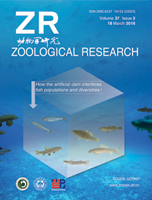
|
Zoological Research
Kunming Institute of Zoology, Chinese Academy of Sciences
ISSN: 2095-8137
Vol. 38, No. 4, 2017, pp. 191-197
|
 Bioline Code: zr17024
Bioline Code: zr17024
Full paper language: English
Document type: Report
Document available free of charge
|
|
|
Zoological Research, Vol. 38, No. 4, 2017, pp. 191-197
| zh |
新西兰壁虎( Hoplodactylus maculatus  )粘附尾垫鳞片的再生可作为一般实验模型来分析蜥蜴刚毛的形成 )粘附尾垫鳞片的再生可作为一般实验模型来分析蜥蜴刚毛的形成
Alibardi, Lorenzo & Meyer-Rochow, Victor Benno
在树栖的新西兰壁虎(Hoplodactylus maculatus)尾巴的再生过程中,一组新的尾鳞也被再生,这组尾鳞被改进成具有5-20米长刚毛的垫片。在光镜和电子显微镜图像的基础上,描述了形成这些特化鳞片的阶段,这些鳞片由再生尾巴的真皮内陷的表皮突起形成。在这些突起内,与趾垫描述的过程类似,分化的透明层与角皮层(Oberhäutchen)的微刺和刚毛接触。一层透明的细胞质围绕着正在生长的微小刚毛,最终在这些刚毛及其刮板式末端周围角化,随后新的刚毛独立在表皮表面上。新的粘附垫帮助壁虎保持其再生尾巴的抓握功能,与轴向骨架(由柱状弹性软骨组成)一起,垫片可以使再生的尾巴像原始尾巴一样卷曲在细枝条和小枝条之间。尾部粘附垫的再生代表了研究在正常或实验操作下确定刚毛形成的细胞过程的理想系统,因为可以依次分析刚毛形成的进行阶段。
壁虎;蜥蜴;再生;表皮;尾垫鳞片;粘附;抓握功能;超微结构
|
| |
| en |
Regeneration of adhesive tail pad scales in the New Zealand gecko ( Hoplodactylus maculatus  )(Reptilia;Squamata;Lacertilia) can serve as an experimental model to analyze setal formation in lizards generally )(Reptilia;Squamata;Lacertilia) can serve as an experimental model to analyze setal formation in lizards generally
Alibardi, Lorenzo & Meyer-Rochow, Victor Benno
Abstract
During the regeneration of the tail in the arboreal New Zealand gecko (Hoplodactylus maculatus) a new set of tail scales, modified into pads bearing setae 5-20 μm long, is also regenerated. Stages of the formation of these specialized scales from epidermal pegs that invaginate the dermis of the regenerating tail are described on the basis of light and electron microscopic images. Within the pegs a differentiating clear layer interfaces with the spinulae and setae of the Oberhäutchen according to a process similar to that described for the digital pads. A layer of clear cytoplasm surrounds the growing tiny setae and eventually cornifies around them and their spatular ends, later leaving the new setae freestanding on the epidermal surface. The fresh adhesive pads help the gecko to maintain the prehensile function of its regenerated tail as together with the axial skeleton (made of a cylinder of elastic cartilage) the pads allow the regenerated tail to curl around twigs and small branches just like the original tail. The regeneration of caudal adhesive pads represents an ideal system to study the cellular processes that determine setal formation under normal or experimental manipulation as the progressive phases of the formation of the setae can be sequentially analyzed.
Keywords
Gecko lizard; Regeneration; Epidermis; Tail pad scales; Adhesion; Prehensile function; Ultrastructure
|
| |
© Copyright 2017 - Zoological Research
Alternative site location: http://www.zoores.ac.cn/
|
|
